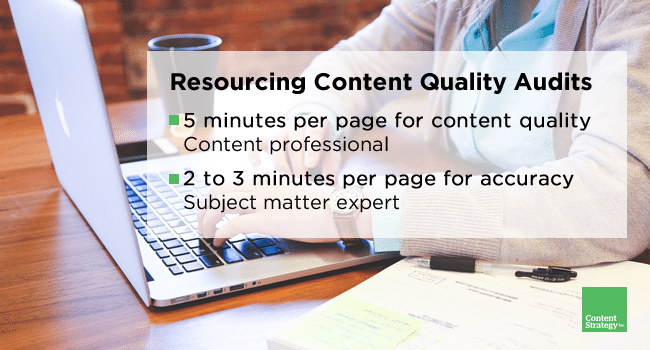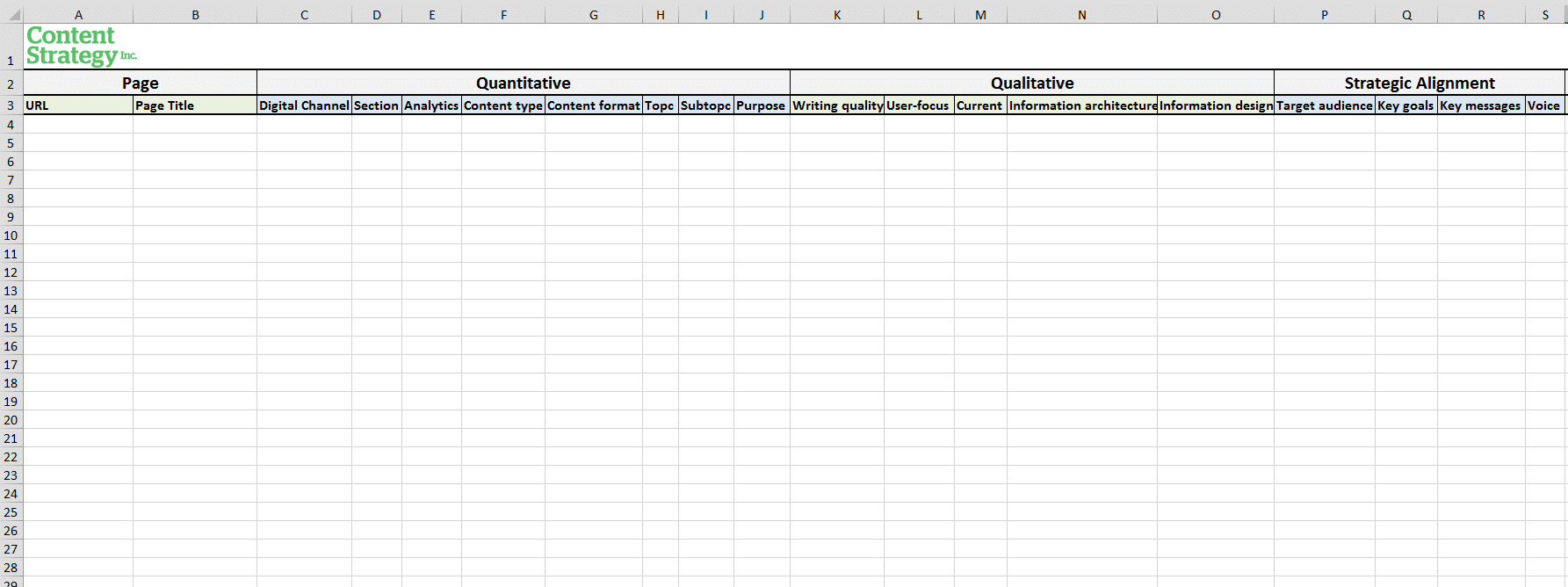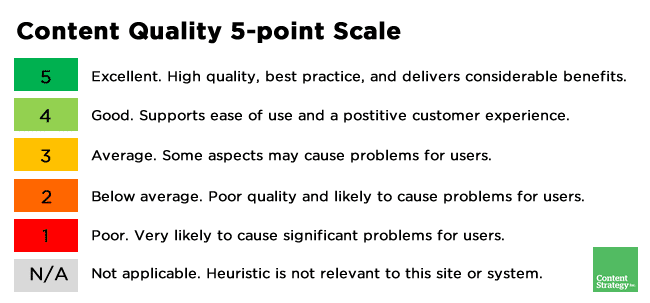When the going gets tough, the tough get auditing
If you want to get serious about how your content aligns with your brand and impacts customer perceptions, then do a qualitative, or quality audit.
Content audits are foundational activities that inform your content strategy. They’re like a content reality check, providing you with a data-based view of the content on your website and other online or offline channels.
There are different audit types, like quantitative, competitive, and organizational, but a quality audit provides you with the best information about how your content may be perceived.
Why audit for quality?
Quite often, companies think their content is good simply because they’ve covered off a laundry list of topics. Whether their content actually meets customer needs is a different story.
You may have pages that describe the features of your software, for example, but that doesn’t mean your customers can scan them easily, understand what it is you sell, or even know how to purchase it. If there are spelling or grammar mistakes, an inconsistent use of terminology, or vast differences in tone, your content may be confusing them further.
A quality audit can tell you things like: 75% of pages in the support section are likely to be confusing to users, difficult to scan, and have no clear call to action or next steps.
Those numbers are hard to ignore.
What is a quality audit?
A quality audit grades your content against a set of subjective quality criteria: everything from brand messaging guidelines to web industry best practices. The important thing to remember is that you have to agree on the criteria before you start.
A quality audit grades your content against a set of subjective quality criteria. Click To TweetA quality audit helps reveal problems in areas of plain language, writing mechanics, grammar, spelling, and punctuation. When these writerly things aren’t done well, your content appears shoddy and unprofessional.
A quality audit also considers voice and tone, or how the content sounds and feels in different contexts. Do your sales pages and support content convey the same brand voice but in an appropriate tone? A chummy tone in one context can be annoying or disrespectful in another.
You can also use a quality audit find out about the extent of a problem within a channel. For example, is there content written by specific authors, in certain sections, or on topics that is weaker than others?
Lastly, a quality audit looks at content accuracy or completeness. Content that is clearly out of date, flat out wrong, or incomplete is bad for business.
Lay the groundwork with realistic resourcing
Since people have different ideas on what constitutes quality, the first thing you need to do when preparing for an audit is resource the activity appropriately.
Quality audits in particular require people who are content professionals: writers, content strategists, and editors. Follow these best practices to make sure you have the right resources in place:
- Use content experts with strong writing skills specific to the channel they’re reviewing.
- Only use subject matter experts to review content for subject accuracy.
- Don’t use content authors as auditors. Having the person who wrote the content evaluate it for quality standards is a bad idea.
- Make time and dedicate the appropriate resources. An audit shouldn’t be something undertaken in your spare time (as if you have any).
Content Audit Resourcing Guideline
Our rule for resourcing audits is to budget for about five minutes per page. To have a subject matter expert review technical material for accuracy, budget two to three minutes per page.
Quality Audit Criteria
Once you have the resources in place, it’s time to give careful thought to what you’re auditing for. In other words, the audit criteria.
We often use some or all of these six criteria in our quality audits.
Content organization
- Content heading structure is consistent and parallel
- Content is easy to scan (no walls of text)
- Content flows from the most important, to the least important
- Page elements, such as images, videos, and links are used appropriately and consistently
Plain language, grammar & punctuation
- Content contains no jargon
- Content uses active voice
- Content follows web writing best practices
- Content avoids nominalizations, redundancies, cliches, and long sentences
Content focus, efficiency, effectiveness, and context
- Content is focused on one topic and purpose per page
- Content conveys information succinctly. No info dumps
- Content is easy to understand
- User has sufficient context to understand the page if the page can be landed on via natural search or browsing. The user does not need to have visited previous pages to understand the current one
Accuracy
- Content is up to date
- Content contains correct information
Voice and tone
- Content meets brand guidelines
- Tone is appropriate for the audience, purpose, and channel
Calls to action or next steps
- Content contains clear calls to action or next steps
- User knows what to do next
Get started, or ready… set… audit!
The nuts and bolts of an audit, no matter what kind, are simple. You need the right people, the time to do it, and a spreadsheet.
Your spreadsheet should list all the URLs of the pages you’re auditing, and the audit criteria. In a large website with multiple sections, we create separate sheets for each section.
To see an example, download our Content Quality Audit Template and adapt it to suit your needs.
The 5-point scale
Since evaluating content quality is inherently subjective, we use a number scoring system to rank content consistently. A score of 5 means the content is high quality, follows best practices and meets the user needs. A score of 1 means the content is likely to cause significant problems for users.
By ranking pages between 1 and 5 for all criteria and then averaging the scores, we can calculate an overall quality score for each area of the website.
For example, a page littered with spelling mistakes and poor grammar would rank a 1 or 2 (depending on the cringeworthiness of the copy). A different page with an overly casual tone that doesn’t fit the voice values of the brand would rank low for voice and tone.
Tips for auditors
Auditing really large websites can be brain-numbing, we know.
If you have multiple auditors, make sure you audit a sampling of pages together so that you can agree on what rates a 5 versus a 1. Or better yet, find examples of pages that do a good job in all your focus areas and keep these handy as references.
Make time for periodic check-ins throughout the audit to sync with your team, or revisit the standards and guidelines.
You’ll find these check-ins extremely helpful once you start. Even with enough coffee and the best intentions, you can easily lose perspective after looking at pages and pages for hours on end. Take a break, regroup with your teammates, or have them check your work. Donuts help too.
Present your findings as a scorecard
Once your audit is complete and you’ve proudly surveyed your spreadsheet, brimming with numbers and values, you’re ready to analyze.
We’ll be walking through the steps for doing an audit analysis in a separate article, but one technique we find very powerful in presenting some of the quality findings is the scorecard.
For example, to evaluate all the pages in your site for plain language, you’d add the scores for that column in your spreadsheet, and then calculate the average. An average score of 3.7 would warrant a B.
By turning the numerical results into report card-style grades, you can present audit results to senior stakeholders in a meaningful way. Everyone loves getting an A or A+. Getting a D, maybe not so much. But whatever the result, you’ll be able to say that the grades are backed up by data.
Finally, avoid this number one mistake
The biggest mistake people make when it comes to quality audits is that they don’t do them.
The biggest mistake people make when it comes to quality audits is that they don’t do them. Click To TweetQuality audits are an important part of establishing your content baseline. They are discovery tools, along with stakeholder interviews, user surveys and research, and journey mapping.
Unlike those other tools, though, audits are the only tool that gives you an empirical look at the state of your content today. And a quality audit, although still subjective, can provide you with valuable insights if done right.
Do you still have burning questions about quality audits or content auditing in general? We’d love to hear them. Leave a comment on LinkedIn or connect with us on Twitter.
Further reading
Content toolkit: Content quality audit template
How to evaluate content using a content scorecard




